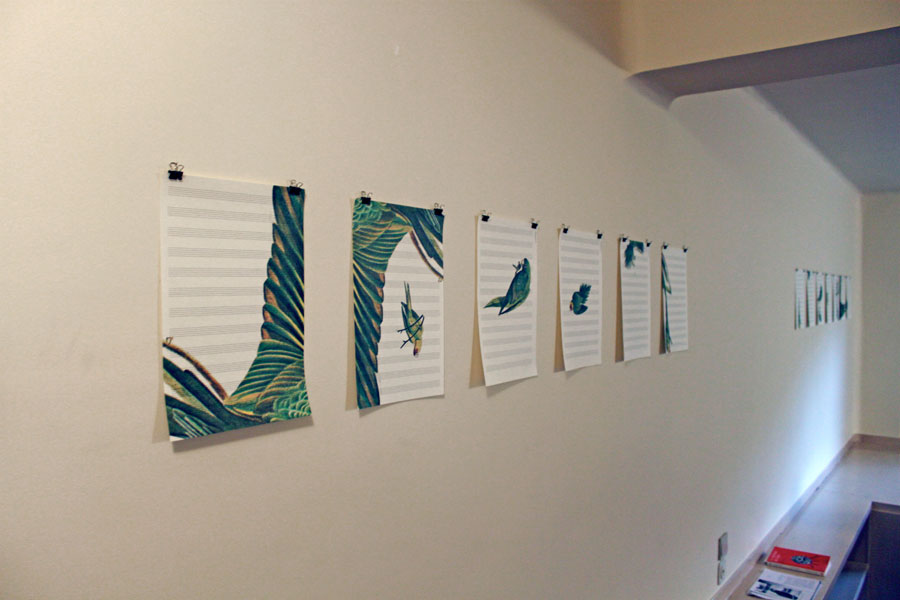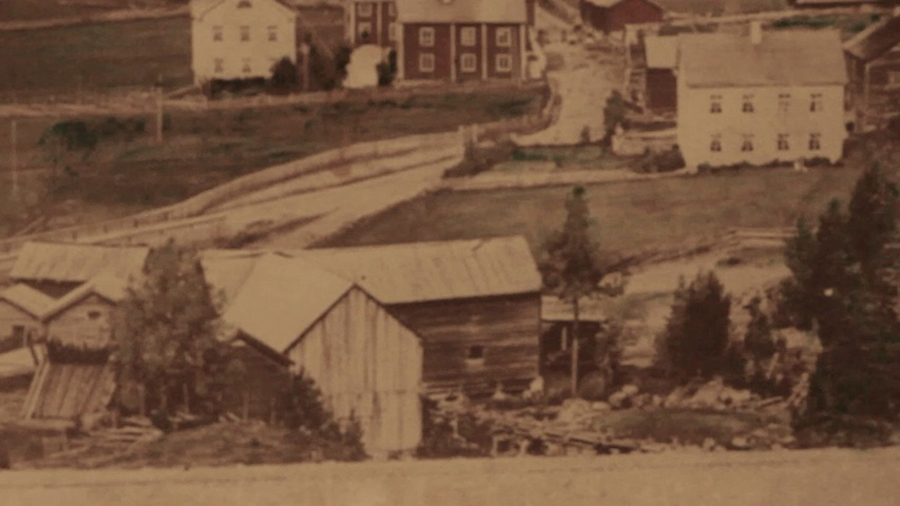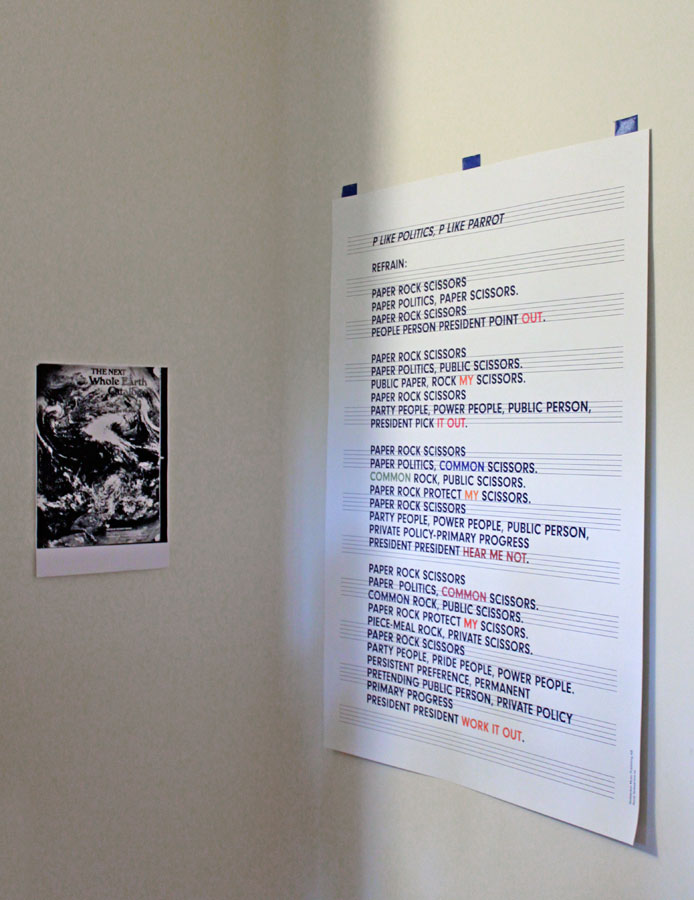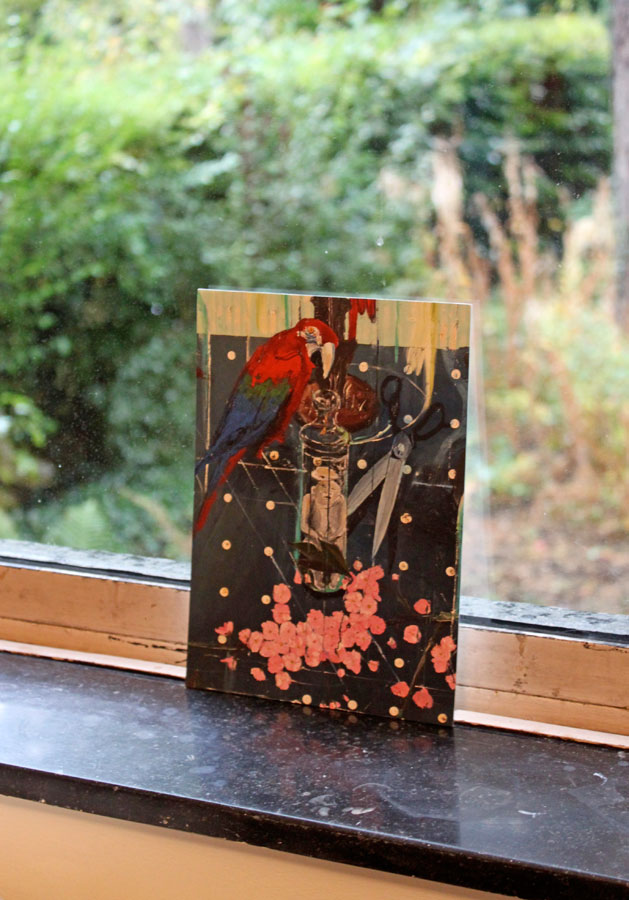Qu’est-ce qui peut bien relier une conversation entre deux architectes suédois, discourant de tendances actuelles en architecture contemporaine, des extraits choisis tirés de discours de G.W. Bush, les réunions hebdomadaires d’une chorale d’amateurs du fin fond de la Suède ou encore des représentations de cet animal emblématique qu’est le perroquet? A première vue, bien peu de choses, répondrait-t-on. Et pourtant…
Ce qui pourrait passer pour un rébus se met tout naturellement en place quand l’on prend le temps nécessaire de s’attarder dans l’exposition d’Eleni Kamma à la Maison Grégoire. C’est que le travail d’Eleni Kamma est un travail qui se déploie, dans le sens étymologique du terme (porter au-delà), dans une logique de translation constante. Il procède souvent à la façon d’un discours fonctionnant par associations et inductions, et dont les vides, ellipses, silences ou manques apparents sont précisément au moins aussi signifiants que ses éléments explicites, exprimés.
C’est aussi une œuvre, qui, par delà son apparent éclectisme lexical de formes et de styles, procède suivant une logique interne extrêmement sélective.
Ses installations ou expositions sont donc à appréhender in toto, à la façon de phrases plastiques, libres et flottantes, recourant à un langage personnel où éléments visuels, plastiques ou linguistiques se complètent, construisant ainsi de véritables rhétoriques « installatives » participant d’une logique de gesamtkunstwerk.
Les œuvres qui forment le noyau de cette exposition sont deux vidéos que Kamma a réalisées en Suède à l’occasion de sa résidence à Iaspis en 2011, à savoir : « Malin and Tor: Two architects in conversation ». Et la vidéo éponyme: « P like Politics, P like Parrots ». Si ces deux vidéos peuvent à première vue, ou, plutôt, audition apparaître fortement ancrées par leur contenu rhétorique et discursif dans le contexte local, c’est sans doute précisément par leur propre déplacement, leur extraction du contexte d’origine que l’on peut le mieux apprécier le message méta ou infra linguistiques, les analyses sociopolitique et esthétique qu’ils véhiculent.
« Malin and Tor: Two architects in conversation » suit en deux épisodes l’échange que poursuivent ces deux architectes. Pour une première partie, l’entretien porte sur une analyse de la crise de la dimension spéculative de l’architecture contemporaine, au profit de la montée en puissance concomitante de l’aspiration au spectaculaire sévissant de nos jours. En guise de toile de fond de cette vidéo se déroule sous nos yeux l’architecture temporaire, très anti spectaculaire précisément, d’une salle en plein montage de l’Arkitektuurmuseet de Stockholm. Filmé par une camera résolument exploratrice, en constant mouvement giratoire, le décor agit à la façon d’une membrane textile, souple, quasi organique et fragile, tel un contrepoint signifiant à la réflexion menée sur la vocation et la dimension spectaculaires de l’architecture dans le tissu social.
Dans la deuxième partie de l’entretien, les deux architectes, reprennent leur échange en évoquant le succès et la floraison des chorales au sein de la société suédoise offrant la possibilité d’une expression individuelle et collective indirectes, tout en exprimant le besoin de recréer un sens de communauté faisant sans doute défaut à l’espace public.
Cette partie de leur conversation offre une transition toute naturelle à la deuxième vidéo d’Eleni Kamma, qui nous restitue une répétition bien spécifique d’un chœur amateur de la paroisse de Bräcke. La structure du texte qu’Eleni Kamma propose à la chorale après l’avoir écrit à leur intention, reprend le rythme ternaire et répétitif du jeu bien connu « papier ciseau caillou ». L’élément subversif apparaît progressivement lorsque l’on s’aperçoit que le texte repose sur la succession de paroles à connotation politiques (people, pouvoir, public, privé, etc.), commençant toutes par la lettre P-, et toutes tirées d’un discours de 2003 de G.W. Bush. Leur répétition, comme fortuite, incontrôlée et accidentelle, induite par la structure même du jeu offre en soi une mise en abyme troublante et métaphorique sur le fonctionnement arbitraire de nos systèmes politiques.
La complémentarité des deux vidéos apparaît ainsi progressivement. Elles partagent l’usage giratoire de la caméra, explorant inlassablement des espaces décors quasi vides, qui ne sont habités que par la présence du son de la voix humaine. Si la forme discursive articulée de « Malin & Tor » cède la place dans « P like Politics…» à une expression polyphonique et apparemment plus erratique et confuse, dans les deux cas, les contenus textuels progressent et se développent par des translations / associations de sens ou de sons.
L’intérieur de la Maison Grégoire se prête à merveille à la présentation de ces œuvres. Combinant la pureté de ses lignes modernistes avec la dimension domestique de lieu habité de façon très minimale, il offre un écho direct aux décors utilisés par Kamma. En outre, conçu par van de Velde comme un statement résidentiel fonctionnel et anti spectaculaire, son architecture se déploie de façon organique à l’échelle de l’homme: le rez-de-chaussée en particulier s’appréhende comme un espace s’articulant autour d’un escalier central et qui induit une circulation giratoire qui n’est pas sans rappeler l’usage de la camera privilégié par Kamma.
A l’occasion de « Found in Translation, chapter P » une sérigraphie originale en 15 exemplaires, un livret et une série de 15 prints spécialement produits pour l’occasion viennent expliciter le lien entre les deux vidéos.
Texte de Emmanuel Lambion
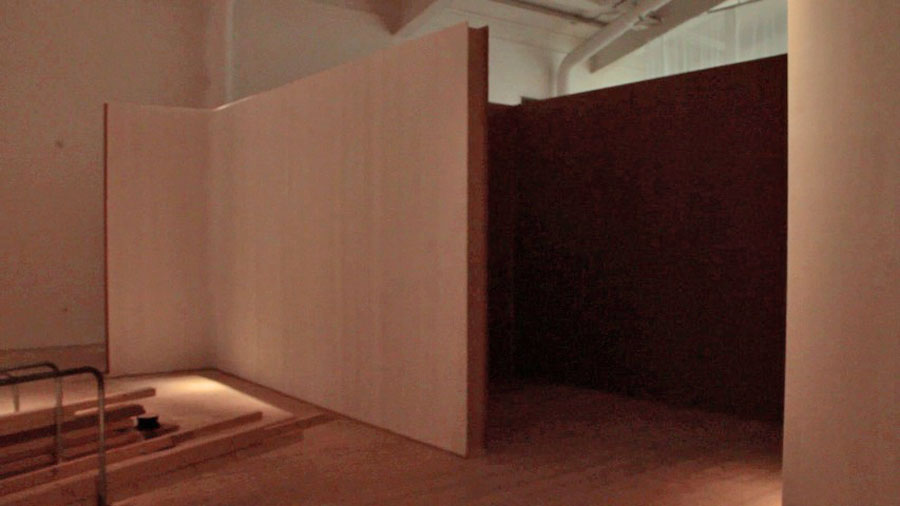
Malin and Tor (Two Architects in Conversation), 2011
33:16 minutes, HD video, color, stereo sound, 16:9, English spoken, NL
P Like Politics, P Like Parrots, 2011
17:42 minutes, HD video, color, stereo, English and Swedish spoken, NL
What on earth would at first sight appear to connect a conversation between two Swedish architects reflecting on a current trends in architecture, excerpts from presidential speeches by G.W. Bush, the weekly practice of an amateur choir and the archetypal image of parrots in our Western imagination? Hardly anything, one would guess. And still… What would seem to be a kind of rebus comes into pieces when one takes the necessary “speculative” time to visit and envision thoroughly the installation devised by Eleni Kamma for Maison Grégoire.
For Eleni Kamma’s work is a work which unfolds itself in permanent translation (hereby intended in its etymological meaning of “bringing beyond”), much in the fashion of an associative and inductive discourse, where gaps and voids are precisely as meaningful as its formal constitutive and explicit, expressed elements. It is a work which, following a seemingly casual, but, at the same time, very specific and selective approach, resorts to visual, plastic and linguistic elements to articulate itself into gesamtkunstwerk installations. Kammas installations and or exhibitions are to be apprehended in totum, like a free floating sentence elaborated in a personal language, resorting to an eclectic vocabulary.
The works forming the chore of this exhibition are two videos, both realised in Sweden on the occasion of Eleni Kamma’s residency @ Iaspis in 2011, namely : Malin and Tor : Two architects in conversation and the eponymous : P like Politics, P like Parrots
Both videos are at first sight or, rather first hearing, strongly anchored by their discursive and linguistic content in the Swedish local context. Beyond, it is maybe this very displacement out of their context of origin which helps appreciate the general, meta-linguistic message and the socio-political and aesthetic comments they convey.
Malin and Tor : Two architects in conversation follows in two episodes the discursive exchanges between the two aforementioned architects. The fist part of their conversation articulates around an analysis of the crisis of the speculative element in contemporary architecture, paired with a reflexion on the “spectacular” fashion, as a current operational mode, mirrored by the very alteration of the meaning of their etymological radical. Background for this video is the mobile, evolving and precisely anti-spectacular setting of a room of the Arkitektuurmuseet, filmed while an exhibition is being mounted. As such, through the very explorative and rotating use of the camera, the decor functions as a sort of fragile organic filter, acting as a meaningful metaphoric counterpoint to a reflexion of the spectacular role / dimension of architecture in the social fabric.
In the second part of the video, the two architects resume their conversation by tackling i.a. the phenomenon of the success and flowering of singing choirs apprehended as a sort of social architecture, which may sometimes be seen as “absorbing the lack of talents”, whilst revealing the need of a sense of community and offering the possibility for a mediated discursive social expression.
This part of their conversation offers the natural transition for Kamma’s second video, reflecting a specific rehearsal of the amateur choir of the Parish of Bräcke.
The composition of the text proposed by Kamma and rehearsed by the singers, originates in the rhythm and structure of the famous hands game “Paper-Rock-Scissors” progressively subverting it through the inclusion of political P- words, all (not so) randomly chosen from a 2003 speech by George W. Bush and introducing the concepts of public, common sphere vs. private one, power vs. people etc.
The casually repetitive, alternating character of the seemingly endless game offers an indirect metaphor on the arbitrary functioning of our political systems, apprehended as a carousel-like vortex.
If their correspondences appear but progressively, the two videos function very well together.. They share the same use of an explorative camera, rotating around itself in a seemingly empty décor, just inhabited by the characters through speech or singing. An articulated but also free and associative discourse in the first video makes place in the second video for a more polyphonic and seemingly loose verbal exchange, nevertheless carefully devised and prepared by the artist. Both discursive contents progress and develop in associative translations of meanings and / or phonetics to eventually climax in the P like Politics piece in a parody of a subversive sung “game”. It there where one can feel that the formal and thematic choices made within each video (and in the link between the two of them) are deeply meaningful.
The domestic interior of Maison Gregoire appears to be the perfect setting for the presentation of the two videos. The premises combine the purity of their modernist lines along with a decidedly domestic, lived in (if sparsely furnished) interior, thus echoing the two distinctive backgrounds filmed in the Eleni kamma’s videos. Precisely conceived by van de Velde as an anti-spectacular statement, the architecture is organically articulated and based on human scale. A final touch is brought about by the fact that the ground floor used for the exhibitions is designed for a circular de-ambulation around a central staircase, thus much on the line of the circular rotating character of the filming in Kamma’s videos.
On the occasion of Found in Translation, chapter P, an original silkscreen print, booklet and a series of 15 prints further articulate the implicit connection between the videos.
[sociallinkz]
